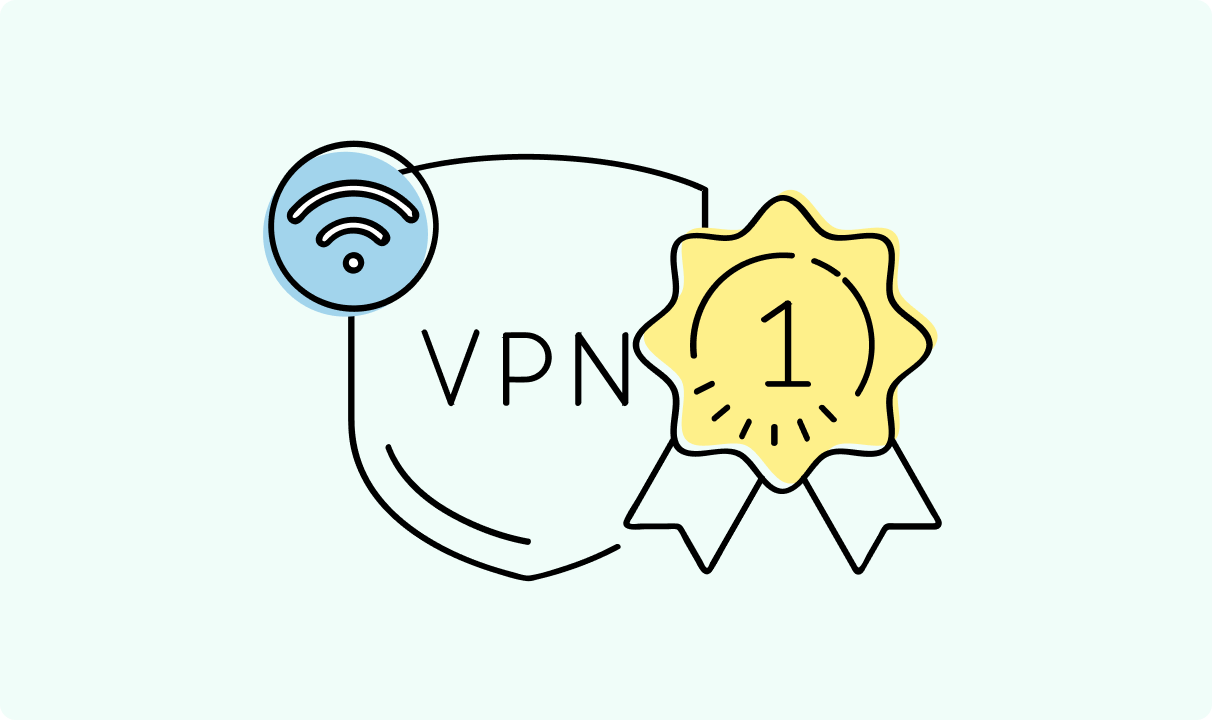How to Get Free Wi-Fi: Apps, Hotspots, and Safety Tips
Key takeaways:
- Always use a VPN when connecting to any free Wi-Fi or public hotspot.
- Apps like Wi-Fi Map and Instabridge help you easily get free Wi-Fi wherever you are.
- Stay close to routers and use ISP Wi-Fi hotspot networks for faster and safer internet.
If you ever traveled abroad or simply went outside and forgot that you’re out of mobile data, you probably felt a need to find free Wi-Fi somewhere. Being stranded without internet can be stressful, especially if you’re in a hurry and don’t know where to go without a GPS.
To help you forget this stress, we put together this guide that will explain how to get free Wi-Fi quickly. After reading, you will know about the best places to find it, the best apps to use, and how to remain safe on public Wi-Fi networks.

Adomas Šulcas
5 min read

Best Places to Find Free Wi-Fi
There are a lot of spots that offer free Wi-Fi now, especially in modern countries. You may be surprised how many places allow you to connect to their networks for free.
Cafes & Coffee Shops
If you want free Wi-Fi, coffee shops are your best bet. Big chains like Starbucks or your local commercial cafes usually have decent Wi-Fi networks. You can get a coffee, connect to the internet, and look for what you need.
If the network isn’t password-protected and you don’t want to spend money for coffee, you can try and catch free internet from outside. However, it won’t work everywhere all the time. In addition, some people would consider it to be bad manners.
Libraries & Community Centers
Libraries also offer free Wi-Fi for students, remote workers, or anyone else needing free internet access. The atmosphere is also quiet, which makes it one of the best places to study or work.
The best thing about libraries is that you don’t have to feel ridden with guilt for using the free internet if you don’t buy anything, because there’s nothing to buy. Aside from the occasional vending machine, of course.
Hotels & Airports
For hotels, most of the time you don’t even need to be a client. Hotel lobbies have decent free Wi-Fi hotspots. However, you may be confronted by a front-desk worker if they notice you staying there for a long time.
As for airports, most of them are not in very convenient areas to jump in for a quick search with free internet. On the other hand, no one should give you any trouble if you just sit somewhere and browse the internet.
Just connect to a public Wi-Fi hotspot wherever you are and you’re good to go. Some places may ask for your email, though, to connect.
Shopping Malls & Retail Chains
Large malls such as Target, Walmart, and more usually have free Wi-Fi hotspots. However, they may be slow and unreliable to access something quickly.
For a better connection, you could try finding a comfortable spot near a router (if you can find it) and enjoy a more solid Wi-Fi network connection. If it’s still slow, you may want to move around and find an area where the public Wi-Fi hotspot is stronger.
Public Parks & Transit Hubs
Some cities now offer public Wi-Fi networks in parks, bus stations, subways, and other major public places. Chances are that it will be even less reliable than a shopping mall connection, but you can still get free Wi-Fi.
Wherever you choose to go, make sure to bring your power bank if it’s a longer journey. Find a place that’s near the router for better hotspot signals, and use your power bank instead of looking for an outlet somewhere to charge your device.
Best Apps to Locate Free Wi-Fi
Wi-Fi Map
Wi-Fi Map has a huge database of free Wi-Fi hotspots. All you need to do is enter the city you’re in and you will get a map with pins over the places that offer free Wi-Fi. That’s it. It may not be perfect and may not cover all the places, but it’s a great place when you’re in a pickle.
Instabridge
Instabridge can also help you find free Wi-Fi wherever you are. It has more than 20 million free Wi-Fi hotspots around the world. The app has more than 250M downloads and people rate it positively: it has a 4.5 average rating. Download the app and find your nearest free Wi-Fi provider.
Wi-Fi Master
Wi-Fi Master lets you find and connect to free Wi-Fi hotspots safely. It even checks if the Wi-Fi networks are secure before letting you join. But if you’re looking for true protection while using free public networks, you may want to consider a VPN that encrypts all your traffic.
Use Your Internet Provider’s Wi-Fi Network
Which Providers Offer Free Hotspots
Companies like Xfinity, Spectrum, and AT&T offer free Wi-Fi hotspots to their customers. If you already pay for internet at home, you might have free Wi-Fi outside, too. Make sure to check your contract terms or contact their customer support to learn more about your internet privileges.
How to Log In to ISP Hotspots
When you see your provider’s Wi-Fi hotspot, log in using your account email and password. It’s still free Wi-Fi, but a little safer than random public Wi-Fi networks where hackers may be lurking to steal your sensitive or personal information.
Public vs ISP Wi-Fi: Pros and Cons
ISP Wi-Fi networks are usually faster and more secure than normal public Wi-Fi hotspots. But you may need to re-login quite often which is bound to get annoying after some time.
Stay Safe on Free Wi-Fi: Essential Tips
Using public Wi-Fi networks is risky if you’re not careful. Follow these tips to stay safe:
- Always use a VPN. It keeps your data private, even on sketchy Wi-Fi hotspot connections.
- Check for HTTPS in web addresses. If the website is on the HTTP protocol, you may want to stay clear as it’s a less secure one.
- Keep important sessions at home. Don’t log into banks or sensitive accounts while on free Wi-Fi.
- Keep your antivirus and OS updated. Outdated software can lead to data leaks and other privacy issues.
- Stay manual. Turn off auto-connect for public hotspots and unknown networks.
- Use privacy-focused browsers. Try using browsers like Brave or Firefox for more privacy.
A VPN can save your day when browsing on sketchy free Wi-Fi networks. Not using a VPN on any public network whatsoever is basically asking for trouble. You wouldn’t leave your doors unlocked when leaving the house, would you? Do the same for your connection.
Conclusion
Now you know how to get free Wi-Fi wherever you go. From coffee shops to parks, and using apps like WiFi Map, you have tons of options for finding a Wi-Fi hotspot. Just make sure you’re using a VPN to help keep your free Wi-Fi connection safe.
Stay smart, be safe, and respect the rules of public hotspot places.
Frequently Asked Questions
Can I get free Wi-Fi without a password?
Yes, many public Wi-Fi networks and free hotspots don’t require a password, especially in parks and shopping malls. Or, if your friend has unlimited data, you can ask them to share a mobile hotspot. Make sure to use a VPN for any public and free hotspots to protect your privacy.
Is it illegal to use someone’s unsecured Wi-Fi?
If it’s truly open, it’s usually not illegal. But using a free Wi-Fi network or a mobile hotspot that you’re not allowed on, could still get you in trouble. As a rule of thumb, think if you’re respecting the network provider’s rules before connecting and you should be good.
What’s the difference between a hotspot and a router?
A router connects devices to each other and the internet. A Wi-Fi hotspot shares that internet connection publicly. In short, a hotspot is the thing you connect to, and a router is the thing that enables that connection from the technological end.
Is tethering from a friend’s phone considered “free Wi-Fi”?
Technically, that could be a yes. Your friend’s mobile hotspot shares their mobile data, so it’s a free hotspot for you, but it’s not free for your friend. Unless your friend has unlimited data, then it’s a lot better than a public hotspot somewhere else.

Author
Adomas Šulcas
Chief Operating Officer at Growth Bite
Adomas is a technical writing expert who founded Growth Bite, a digital marketing company, focused on providing high-value SEO and content marketing services to SaaS companies.
Related articles

4 min read
Best Residential VPN Providers in 2025
A Virtual Private Network (VPN) encrypts your traffic and hides your IP address. The way these functions are accomplished affects various aspects of your online privacy and security.
Here, we'll consider using residential IP addresses instead of those originating from a data center. A residential VPN has advantages compared to traditional ones, but there are some caveats. It all boils down to residential VPN providers.
The worst ones may even create more risks than benefits. We'll end this article with a list of the best residential VPN providers on the market.

Guoda Šulcaitė
4 min read
Ethernet vs Wi-Fi: Which One is Better?
Ethernet and Wi-Fi are the two main ways to connect your computer to the internet. While Wi-Fi has received significantly more attention in recent years, especially among consumers, due to its simplicity and flexibility, ethernet is still widely used in various other applications.
Even if Wi-Fi is significantly more popular, it isn’t strictly better. Both methods have their benefits and drawbacks. Wi-Fi’s popularity comes from its ease-of-use and flexibility, but an ethernet connection can be much more useful in certain scenarios.

Adomas Šulcas

5 min read
How to Change Chrome Proxy Settings: The Ultimate Guide
A proxy server is an easy alternative to a VPN that can perform most of the functions of the latter. It’s a server that stands between your device and the destination server, taking your connection requests and forwarding them in your name.
Destination servers in almost all cases see the proxy server as the originator of the request. As such, proxies are widely used in various, mostly business-related applications whenever privacy, security, location changing, and several other factors are at play.

Guoda Šulcaitė